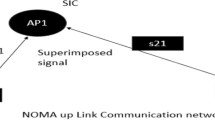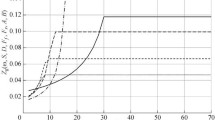Abstract
The subject of this paper is the design and evaluation of an efficient errorcontrol scheme for indoor cellular wireless broadband access networks, whichcan be considered as the wireless extension of a fixed quality-of-serviceoriented network (e.g., based on the ATM- (asynchronous transfer mode-)protocol). In order to improve the high and time-variant probability of transmissionerrors, a novel error control scheme is developed. The protocol calledHYPERFLOW (Hybrid Partial sElective Repeat ARQ with Flow control) representsan efficient combination of a selective repeat and a Go-Back-N ARQ- (automaticrepeat request-) scheme while keeping the implementation complexity withinlimits. Additionally, it features a flow control mechanism which prevents the channel from being blocked by a user with momentarily hightransmission error probability and thus considerably increases the totalsystem throughput. Furthermore, the HYPERFLOW-protocol is combined with anadaptive forward error control code. The resulting type II hybrid ARQ-schemeis based on the principle of incremental redundancy with redundant symbolsbeing sent only when they are required.A realistic model for the fluctuations of the transmission quality is used forthe performance evaluation of the HYPERFLOW-protocol. It turns out that the adaptive FEC-based error correction scheme can considerably improve thesystem performance.The mean transmission delay, for instance, can be reduced by a factor of upto 10 when the FEC-scheme is properly applied.
Similar content being viewed by others
References
C. Sinner and R. Sigle, “Toward Wireless Multimedia Communications. Current Standards and Future Directions”, Int. J. Wireless Information Networks, Vol. 5, pp. 61–73, 1998.
J. Meierhofer, “Data Link Control for Indoor Wireless ATM Networks”, in Proc. of Wireless'98, July 1998, Calgary, Canada, pp. 517–525.
D. Bertsekas and R. Gallager, Data Networks 2nd ed., Prentice-Hall: Englewood Cliffs, NJ, 1992.
J. Mikkonen and J. Kruys, “The Magic WAND: A Wireless ATM Access System”, in Proc. of ACTS Mobile Communications Summit '96, Granada, Spain, November 1996, pp. 535–542.
F. Bauchot, S. Decrauzat, G. Marmigère, L. Merakos and N. Passas, “MASCARA, a MAC protocol for Wireless ATM”, in Proc. of ACTS Mobile Communications Summit'96, Granada, Spain, November 1996, pp. 647–651.
S. Choi and K.G. Shin, “A Class of Adaptive Hybrid ARQ Schemes for Wireless Links”, IEEE Trans. Veh. Technol., Vol. 50, pp. 777–790, 2001.
N. Fukui, A. Shibuya and K. Murakami, “Performance of Combined ARQ with SR and GBN for Broadband Wireless Systems on a 40 GHz Band Radio Channel”, IEEE Commun. Mag., Vol. 39, pp. 122–126, 2001.
D. Petras and U. Vornefeld, “Joint Performance of DSA++ MAC Protocol and SR/D-ARQ Protocol for Wireless ATM under Realistic Traffic and Channel Models”, Computer Networks, Vol. 31, pp. 903–918, 1999.
M. Zorzi, “Performance of FEC and ARQ Error Control in Bursty Channels under Delay Constraints”, in Proc. of IEEE VTC'98, Ottawa, Canada, May 1998, pp. 1390–1394.
R. Fantacci, “Queueing Analysis of the Selective Repeat Automatic Repeat Request Protocol Wireless Packet Networks”, IEEE Trans. Veh. Technol., Vol. 45, pp. 258–264, 1996.
M. Chiani and A. Volta, “Hybrid ARQ/FEC Techniques for Wireless ATM Local Area Networks”, in Proc. of PIMRC'96, Taipei, Taiwan, October 1996, pp. 898–902.
A. Cannarsi, M. DeMarco and A. Pattavina, “Quality of Service Issues in Extending ATM to Wireless Networks”, in Proc. of IEEE ICUPC'98, Florence, Italy, October 1998, pp. 607–613.
S. Lin, D.J. Costello and M.J. Miller, “Automatic Repeat Request Error-Control Schemes”, IEEE Commun. Mag., Vol. 22, pp. 5–17, 1984.
A. Ohta, M. Yoshioka, T. Sugiyama and M. Umehira, “PRIME ARQ: A Novel ARQ Scheme for High-Speed Wireles ATM – Design, Implementation and Performance Evaluation”, in Proc. of IEEE VTC'98, Ottawa, Canada, May 1998, pp. 1128–1132.
S.B. Wicker and M.J. Bartz, “Type-II Hybrid-ARQ Protocols Using Punctured MDS Codes”, IEEE Trans. Commun., Vol. 42, pp. 1431–1440, 1994.
C. Feyling, “Punctured Maximum Distance Separable Codes”, Electronic Letters, Vol. 29, pp. 470–471, 1993.
S. Haykin, Digital Communications, John Wiley and Sons: New York, NY, 1988.
R. Heddergott, U.P. Bernhard and B.H. Fleury, “Stochastic Radio Channel Model for Advanced Indoor Mobile Communication Systems”, in Proc. of the 8th IEEE Int. Symp. on Personal, Indoor and Mobile Radio Communications (PIMRC'97), Vol. 1, Helsinki, Finland, September 1997, pp. 140–144.
J. Meierhofer, U.P. Bernhard and T. Hunziker, “Finite State Radio Channel Model for Indoor Wireless ATM Networks”, in Proc. of IEEE ICT'98, Vol. IV, Chalkdiki, Greece, June 1998, pp. 39–43.
J. Meierhofer, “Link Quality Control for Wireless ATM Networks”, in Proc. of IEEE ICC'99, Vancouver, Canada, June 1999, pp. 1874–1879.
Author information
Authors and Affiliations
Rights and permissions
About this article
Cite this article
Meierhofer, J. HYPERFLOW: An Efficient Error Control Protocol for Wireless Broadband Access Networks. Wireless Personal Communications 20, 189–203 (2002). https://doi.org/10.1023/A:1013900110730
Issue Date:
DOI: https://doi.org/10.1023/A:1013900110730




